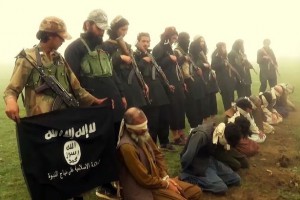Afghanistan is no stranger to horror. For more than three decades, it has witnessed nearly non-stop fighting, both foreign and internecine; occasional atrocities punctuate routine degradations and deprivations.
Still, the beheading of seven civilians in the southern province of Zabul is shocking even for a shell-shocked society. The kidnapping and subsequent beheading of the seven members of the Shi’a Hazara sect was reportedly carried out by Uzbek fighters from the Islamic Movement of Uzbekistan (IMU), which pledged allegiance to the so-called Islamic State earlier this summer.
These IMU fighters, along with Chechens, have been among the most dangerous and persistent foreign fighter elements in Afghanistan since before the 2001 U.S. invasion.
That the Uzbek fighters would join up with the Islamic State is no surprise. The group’s brutality and ‘war against all’ ethos is a better fit for fighters with few ties to the traumatized local communities. This pattern is seen in Syria, Iraq, and Libya, where the Islamic State has preyed on fractured communities unable to depend on government help or fend off the threat themselves. The group tries to peel off younger, more aggressive, members of the community while seeding its ranks with foreign fighters unconcerned with maintaining existing tribal and societal mores.
The beheadings were shocking enough to generate a large protest in the capital of Kabul; protestors denounced the government for its systemic inability or unwillingness to protect all Afghan civilians—least of all, the persecuted Hazaras and women in general. Among the victims of this latest outrage were three women and a nine-year old girl. It is unlikely the protests will lead to sustained change, given the overwhelming scope of the problem.
A report from the United Nations released in September stated that the Islamic State maintains a presence in 25 of the country’s 34 provinces, and that an estimated 10% of the Taliban are Islamic State sympathizers. The combination of these trends with the larger upswell in Taliban victories against a reeling government is a serious blow to an already broken country, and presents the greatest threat to Afghanistan since before 2001.
In Afghanistan, the Taliban has never been a monolothic group. The group’s capabilities and actions vary from district to district, depending on local leadership and opportunity. The notion of a unified Taliban movement was further damaged this month with the announcement of a splinter group led by senior leader Mullah Rasool Akhund, a former top aide to Mullah Omar, the until-recently secretly-deceased supreme leader of the group. The splinter group is composed of perhaps 400 fighters who reject the leadership of Omar’s replacement, Mullah Akhtar Mohammad Mansoor. The IMU fighters that reportedly killed the seven Hazaras were said to be operating alongside the new group. If this splinter group inspires more Taliban fighters to join the Islamic State, Afghanistan will face an even bleaker future.
Everywhere it goes, the Islamic State employs its ‘Management of Savagery’ strategy, embracing shocking and public violence. Likewise, the targeting of Shi’a is one of the group’s driving forces; Abu Musab al-Zarqawi, founder of the Islamic State’s precursor, al-Qaeda in Iraq, attempted and partially succeeded in tearing Iraq apart along sectarian lines. Any Sunni who does not openly support the terrorist group suffers the same fate as any Shi’a, Christian, or Yazidi. Those fighting in Afghanistan for the Islamic State will continue this behavior, and a divided country will be torn further apart.
soufangroup.com



